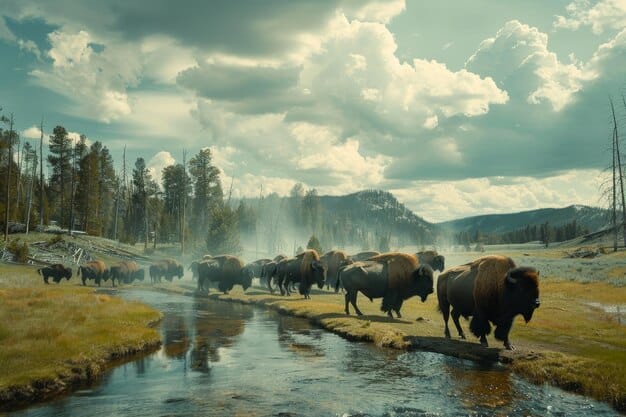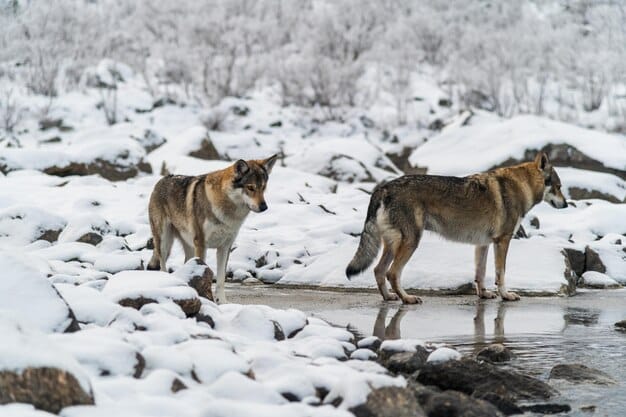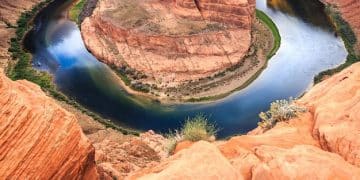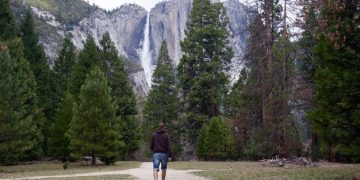Discover the Best US National Parks for Unforgettable Wildlife Viewing

Discover the best US National Parks for wildlife viewing, offering unparalleled opportunities to spot iconic animals like bears, wolves, and a variety of other fascinating creatures in their natural habitats.
Imagine witnessing a bear foraging for food, a wolf pack roaming freely, or a bald eagle soaring overhead. The best US National Parks for wildlife viewing offer these incredible experiences and more. This guide will lead you to the top destinations for unforgettable animal encounters.
Planning Your Wildlife Viewing Adventure
Embarking on a wildlife viewing adventure requires careful planning to maximize your chances of successful sightings and ensure the safety of both you and the animals. Understanding the best times to visit, necessary permits, and ethical viewing practices is crucial for a responsible and rewarding experience.
Best Times to Visit
The time of year significantly impacts wildlife activity and visibility. Spring and fall often provide ideal conditions, while summer can be crowded, and winter presents challenges due to weather conditions. Research the specific park and target species to determine the optimal time for your visit.
- Spring (April-May): Animals emerge from hibernation; mating season for many species.
- Summer (June-August): High season; increased activity, but also more crowds.
- Fall (September-October): Migration season; vibrant foliage provides stunning backdrops.
- Winter (November-March): Fewer visitors; challenging conditions, but unique viewing opportunities.
Remember to check the park’s official website for seasonal closures and advisories.

Essential Gear and Permits
Equipping yourself with the right gear is essential for a comfortable and successful wildlife viewing experience. Binoculars, spotting scopes, and appropriate clothing are indispensable. Depending on the park and planned activities, permits may be required for backcountry access, camping, or specific tours.
Always carry bear spray in bear country and know how to use it. Be aware of your surroundings and follow all park regulations.
In conclusion, careful planning, including timing your visit and obtaining necessary permits, is crucial for a fulfilling wildlife viewing adventure.
Yellowstone National Park: A Wildlife Paradise
Yellowstone National Park, a vast expanse of natural wonders, stands out as a premier destination for wildlife viewing. Renowned for its diverse ecosystems and abundant wildlife populations, Yellowstone offers unparalleled opportunities to observe iconic species in their natural habitat.
From bison grazing in the Lamar Valley to wolves roaming the northern ranges, Yellowstone’s wildlife viewing experiences are truly unforgettable.
Iconic Species and Where to Find Them
Yellowstone is home to a remarkable array of wildlife, including:
- Bison: Commonly seen in Lamar Valley and Hayden Valley.
- Wolves: Best spotted in the northern range, especially during winter.
- Grizzly Bears: Roam throughout the park; exercise caution when hiking.
- Elk: Abundant in meadows and forests throughout the park.
Tips for Successful Viewing in Yellowstone
To maximize your chances of spotting wildlife in Yellowstone, consider these tips:
- Arrive early or stay late: Animals are most active during dawn and dusk.
- Bring binoculars and a spotting scope: Essential for observing wildlife from a safe distance.
- Check recent sighting reports: Park rangers and visitor centers often have current information.
By understanding the park’s diverse ecosystems and following these tips, visitors can enhance their Yellowstone wildlife viewing experience.

Denali National Park: Witnessing Alaskan Wildlife
Denali National Park and Preserve in Alaska presents a unique and awe-inspiring landscape for wildlife enthusiasts. Dominated by the towering peak of Denali, the park spans over six million acres, providing a vast and protected habitat for a variety of Alaskan wildlife.
The park’s remote location and pristine wilderness contribute to exceptional wildlife viewing opportunities, from spotting caribou herds to observing bears in their natural environment.
Key Species to Look For
Denali is home to several iconic Alaskan species:
- Caribou: Often seen migrating across the tundra.
- Grizzly Bears: Inhabit both the alpine and lowland regions.
- Dall Sheep: Grace the steep mountain slopes.
- Moose: Commonly found near rivers and wetlands.
Strategies for Spotting Wildlife in Denali
To effectively spot wildlife in Denali, consider these strategies:
- Take the park bus: The only way to access the interior of the park, narrated tours increase your chances.
- Hike into the backcountry: For a more immersive experience, but requires careful planning and preparation.
- Use binoculars or a spotting scope: Essential for observing wildlife across vast distances.
Denali National Park offers a truly remarkable wildlife viewing experience, with opportunities to see iconic Alaskan species in their natural habitat.
Grand Teton National Park: Wildlife Amidst Majestic Peaks
Grand Teton National Park, with its dramatic mountain peaks and pristine valleys, offers a stunning backdrop for wildlife viewing. The park’s diverse habitats, ranging from sagebrush flats to alpine meadows, support a rich variety of wildlife species.
The park’s commitment to conservation and habitat preservation ensures that wildlife thrives, providing visitors with exceptional viewing opportunities.
What Wildlife Can You Expect to See?
In Grand Teton, you can encounter:
- Bison: Roam the grasslands and sagebrush flats.
- Elk: Commonly seen feeding in meadows, especially during the fall rut.
- Pronghorn: Inhabit the open sagebrush areas.
- Black Bears and Grizzly Bears: Both species are present, exercise caution.
Best Locations and Techniques for Viewing
To enhance your Grand Teton wildlife viewing experience:
- Visit Oxbow Bend and Mormon Row: Popular spots for early morning wildlife sightings.
- Drive the Teton Park Road: Offers scenic views and opportunities to spot wildlife.
- Take a guided tour: Knowledgeable guides can provide insights and increase your chances of seeing wildlife.
The park’s stunning scenery combined with its abundant wildlife makes Grand Teton a favorite destination for nature lovers and wildlife enthusiasts.
Rocky Mountain National Park: Alpine Wildlife Encounters
Rocky Mountain National Park, known for its towering peaks and alpine ecosystems, provides unique opportunities to view wildlife adapted to high-altitude environments. The park’s dramatic landscapes and diverse habitats support a variety of species, from elk and deer to bighorn sheep and pikas.
The park’s commitment to conservation ensures the preservation of its wildlife populations, offering visitors exceptional viewing opportunities.
Key Wildlife Species and Locations
Some of the species you can see in Rocky Mountain National Park include:
- Elk: Abundant throughout the park, especially during the fall rut.
- Mule Deer: Commonly seen in meadows and forests.
- Bighorn Sheep: Inhabit the rocky slopes and alpine areas.
- Pikas: Small mammals found in rocky areas above the treeline.
Tips for Viewing Wildlife Safely and Responsibly
To ensure a safe and responsible wildlife viewing experience:
- Maintain a safe distance: Do not approach or feed wildlife.
- Use binoculars or a spotting scope: For observing animals from afar.
- Be aware of your surroundings: Watch for signs of wildlife activity, such as tracks or scat.
Rocky Mountain National Park offers incredible opportunities to witness wildlife adapted to the challenges of the alpine environment, allowing visitors to connect with nature in a profound way.
Great Smoky Mountains National Park: Appalachian Wildlife
Great Smoky Mountains National Park, a lush and biodiverse sanctuary, offers unique wildlife viewing experiences in the heart of the Appalachian Mountains. Known for its ancient forests and abundant rainfall, the park supports a wide array of species, from black bears and white-tailed deer to salamanders and owls.
The park’s commitment to conservation ensures the preservation of its diverse wildlife populations, making it a prime destination for nature lovers seeking authentic animal encounters.
Notable Wildlife Species and Habitats
Explore the diverse array of wildlife in the Great Smoky Mountains:
- Black Bears: Common throughout the park, but observe from a safe distance.
- White-Tailed Deer: Often seen grazing in meadows and forests.
- Wild Turkey: Frequently spotted along roadsides and in open areas.
- Salamanders: The park is known as the “Salamander Capital of the World.”
Enhancing Your Wildlife Viewing Experience
Consider these tips for an optimal wildlife viewing experience:
- Hike early in the morning or late in the evening: Animals are most active during these times.
- Visit Cades Cove: A popular spot for wildlife viewing, especially deer and bears.
- Take a guided tour: Naturalists can provide valuable insights and safety tips.
The Great Smoky Mountains National Park offers a rich tapestry of wildlife experiences, connecting visitors with the natural beauty of the Appalachian region.
| Key Points | Brief Description |
|---|---|
| 🐻 Best Parks | Yellowstone, Denali, Grand Teton, Rocky Mountain, and Great Smoky Mountains offer diverse wildlife viewing. |
| 🗓️ Best Times | Spring and fall are often ideal due to milder weather and active wildlife. |
| 🔭 Essential Gear | Binoculars, spotting scopes, and appropriate clothing are crucial for viewing. |
| 🚌 Park Tours | Guided tours enhance your chances of spotting wildlife safely and informatively. |
Frequently Asked Questions
▼
The best times to visit Yellowstone for wildlife viewing are early spring and late fall. During these periods, animals are more active and less affected by the summer crowds.
▼
Yes, always maintain a safe distance from wildlife, never feed animals, and carry bear spray in bear country. Be aware of your surroundings and follow park regulations to avoid encounters.
▼
Essential gear includes binoculars or a spotting scope, comfortable hiking boots, appropriate clothing for varying weather conditions, and a field guide for identifying species.
▼
Yes, many parks offer guided tours led by knowledgeable naturalists who can enhance your viewing experience and provide insights into the local ecosystem and wildlife behaviors.
▼
If you encounter a bear, remain calm, do not run, and slowly back away while making noise. If the bear approaches, use bear spray and follow instructions from park rangers.
Conclusion
Exploring the best US National Parks for wildlife viewing offers an extraordinary opportunity to connect with nature and observe animals in their natural habitats. By planning your visits carefully, respecting wildlife, and following safety guidelines, you can create memories that will last a lifetime. Whether you’re hoping to spot bears in Yellowstone or caribou in Denali, these parks provide unforgettable experiences for wildlife enthusiasts of all levels.





